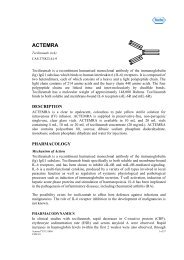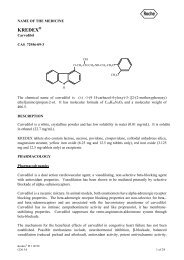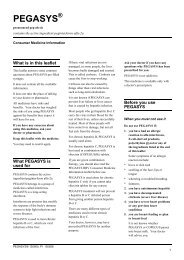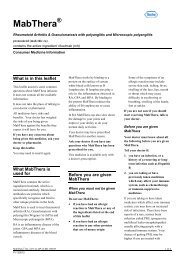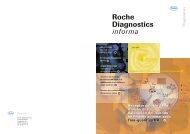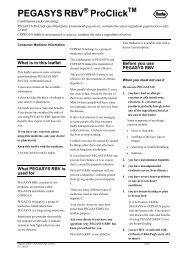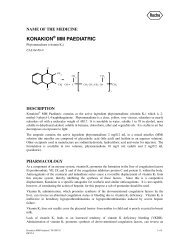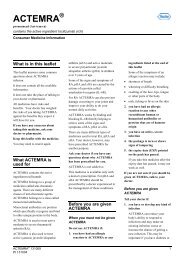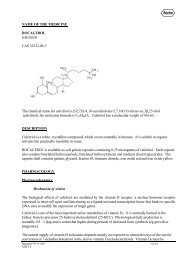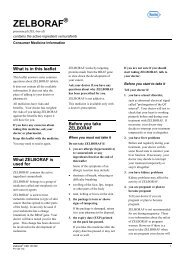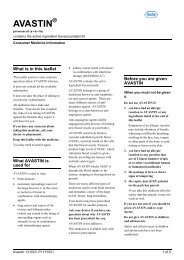Anexate (flumazenil) Product Information (PI) - Roche Australia
Anexate (flumazenil) Product Information (PI) - Roche Australia
Anexate (flumazenil) Product Information (PI) - Roche Australia
You also want an ePaper? Increase the reach of your titles
YUMPU automatically turns print PDFs into web optimized ePapers that Google loves.
.<br />
<br />
NAME OF THE MEDICINE<br />
ANEXATE<br />
(<strong>flumazenil</strong>)<br />
COOCH 2 CH 3<br />
CAS registry number: 78755-81-4<br />
DESCRIPTION<br />
ANEXATE is a colourless to almost colourless clear liquid.<br />
The active ingredient of ANEXATE belongs to the chemical group of 1,2- imidazo<br />
benzodiazepines and is ethyl 8-fluoro-5,6-dihydro-5-methyl-6-oxo- 4H-imidazo [1,5-a] [1,4]<br />
benzodiazepine -3- carboxylate (<strong>flumazenil</strong>). It has a molecular weight of 303.3.<br />
Ampoules contain 0.5 mg active ingredient in 5 mL aqueous solution (for intravenous<br />
administration) and also the following ingredients: disodium edetate, acetic acid, sodium<br />
chloride, sodium hydroxide in water for injections adjusted to pH 4.0.<br />
PHARMACOLOGY<br />
ANEXATE, an imidazobenzodiazepine, is a benzodiazepine antagonist which specifically<br />
blocks the central effects of agents acting through the benzodiazepine receptor by competitive<br />
inhibition. In animal experiments the effects of compounds showing no affinity for the<br />
benzodiazepine receptor, e.g. barbiturates, ethanol, meprobamate, GABA mimetics, adenosine<br />
receptor agonists and other agents were not affected by ANEXATE, but those of<br />
nonbenzodiazepine agonists of benzodiazepine receptors, such as cyclopyrrolones (e.g.<br />
zopiclone) and triazolopyridazines were blocked.<br />
ANEXATE reverses the central sedative effects of benzodiazepines.<br />
The hypnotic-sedative benzodiazepine effects are rapidly reversed by ANEXATE after its<br />
intravenous injection (1-2 minutes) and may reappear gradually within the next few hours,<br />
depending on the half life and dose ratio of the agonist and antagonist.<br />
ANEXATE is well tolerated even in high doses.<br />
ANEXATE may possess some weak intrinsic agonistic (e.g. anticonvulsant) activity.<br />
In animals pre-treated with high doses of benzodiazepines over several weeks, ANEXATE<br />
elicited signs of withdrawal, including seizure. A similar effect was seen in adult human<br />
subjects.<br />
<strong>Anexate</strong> <strong>PI</strong> 130226 Page 1 of 8<br />
CDS 4.0
.<br />
Pharmacokinetics<br />
The pharmacokinetics of <strong>flumazenil</strong> is dose-proportional within and above the therapeutic<br />
range (up to 100 mg).<br />
Distribution<br />
ANEXATE, a weak lipophilic base, is about 50% bound to plasma proteins. Albumin<br />
accounts for two thirds of the plasma protein binding. Flumazenil is extensively distributed in<br />
the extravascular space. The distribution phase of <strong>flumazenil</strong> is approximately 4 minutes.<br />
The mean volume of distribution at steady state (Vss = 0.95 L/kg) is close to that of<br />
structurally related benzodiazepines and indicates tissue binding and/or partitioning of the<br />
drug.<br />
Metabolism<br />
The carboxylic acid was identified in free and conjugated form as the main metabolite in<br />
human urine. In pharmacological tests, this main metabolite was inactive as a benzodiazepine<br />
agonist or antagonist.<br />
Elimination<br />
The average elimination half-life of <strong>flumazenil</strong> is 53 minutes.<br />
ANEXATE is almost completely (99%) nonrenally eliminated. Practically no unchanged<br />
<strong>flumazenil</strong> is excreted in the urine, suggesting complete metabolic degradation of the drug.<br />
Elimination of radiolabelled drug is essentially complete within 72 hours, with 90-95% of the<br />
radioactivity appearing in urine and 5-10% in the feces. Elimination is rapid, as shown by a<br />
short elimination half-life of 40-80 minutes. The total plasma clearance of ANEXATE is on<br />
average 1 L/min and can be attributed almost entirely to hepatic clearance. The low renal<br />
clearance rate suggests an effective reabsorption of the drug after glomerular filtration.<br />
Ingestion of food during an intravenous infusion of <strong>flumazenil</strong> results in a 50% increase in<br />
clearance, most likely due to the increased hepatic blood flow that accompanies a meal.<br />
When administered together with the benzodiazepines midazolam, flunitrazepam or<br />
lormetazepam, the basic pharmacokinetic parameters of ANEXATE were not affected.<br />
Pharmacokinetics in Special Populations<br />
In patients with impaired liver function, the elimination half-life of <strong>flumazenil</strong> is longer and<br />
the total body clearance lower than in healthy subjects. In patients with moderate to severe<br />
hepatic impairment, clearance of <strong>flumazenil</strong> was found to be reduced by 57-74% and the<br />
elimination half-life prolonged up to 2-fold.<br />
The pharmacokinetics of <strong>flumazenil</strong> are not significantly affected in the elderly,<br />
haemodialysis, or renal failure.<br />
<br />
INDICATIONS<br />
ANEXATE is indicated for use in hospitalised patients for the reversal of acute<br />
benzodiazepine effects (overdose or therapeutic). Hospitalised patients are patients admitted<br />
<strong>Anexate</strong> <strong>PI</strong> 130226 Page 2 of 8<br />
CDS 4.0
.<br />
to hospital, inpatient care and under continued professional observation while under the<br />
influence of ANEXATE. Not to be used in outpatients or short stay patients. Not to be used<br />
as a diagnostic.<br />
<br />
CONTRAINDICATIONS<br />
ANEXATE is contraindicated in patients with known hypersensitivity to the drug.<br />
ANEXATE is contraindicated in patients who have been given a benzodiazepine for control<br />
of a potentially life-threatening condition (e.g. control of intracranial pressure or status<br />
epilepticus).<br />
In mixed intoxications with benzodiazepines and cyclic antidepressants, the toxicity of the<br />
antidepressants can be masked by protective benzodiazepine effects. In the presence of<br />
autonomic (anticholinergic), neurological (motor abnormalities) or cardiovascular symptoms<br />
of severe intoxication with tricyclics/tetracyclics, ANEXATE should not be used to reverse<br />
benzodiazepine effects.<br />
PRECAUTIONS<br />
Flumazenil blocks the effects of benzodiazepines in animals and can precipitate<br />
benzodiazepine withdrawal at high doses (also see Pharmacology, Interactions with Other<br />
Drugs and Adverse Reactions).<br />
ANEXATE should be administered cautiously to patients with known or suspected<br />
benzodiazepine dependency or who have been treated with high doses of benzodiazepines for<br />
the weeks preceding the treatment. In such cases the reversal of benzodiazepine effects may<br />
precipitate withdrawal symptoms or convulsions. Titration of the dose may help to reduce<br />
this risk. In case of unexpected signs of withdrawal a slow i.v. injection of 5 mg diazepam or<br />
5 mg midazolam should be given.<br />
ANEXATE may remove the protective effect of benzodiazepines in multiple drug overdose.<br />
There have been several reports of tachyarrhythmia (the pathogenesis of which is unclear)<br />
following ANEXATE administration in the presence of known arrhythmogenic drug<br />
overdose. Convulsions in epileptics previously treated with benzodiazepines may occur.<br />
Consideration should be given to the possibility of resedation, respiratory depression or other<br />
residual benzodiazepine effects following the use of ANEXATE. These patients should be<br />
monitored for an appropriate period based on the dose and duration of effect of the<br />
benzodiazepine employed.<br />
The use of ANEXATE in intensive care units for the interruption of long term/over sedation<br />
is not recommended because of a relative lack of clinical experience.<br />
ANEXATE should not be used as a routine empirical means of assessing unconscious patients<br />
in settings where resuscitation equipment and expertise to deal with complications are not<br />
immediately to hand.<br />
Patients with head injury (and/or unstable intracranial pressure) treated with ANEXATE to<br />
reverse the effects of benzodiazepines may develop raised intracranial pressure. In addition,<br />
<strong>Anexate</strong> <strong>PI</strong> 130226 Page 3 of 8<br />
CDS 4.0
.<br />
ANEXATE may be capable of precipitating convulsions or altering cerebral blood flow in<br />
patients with head injury receiving benzodiazepines.<br />
The use of ANEXATE is not recommended in epileptic patients who have been receiving<br />
benzodiazepine treatment for a prolonged period. Although ANEXATE exerts a slight<br />
intrinsic anticonvulsant effect, its abrupt suppression of the protective effect of a<br />
benzodiazepine agonist can give rise to convulsions in epileptic patients.<br />
When ANEXATE is used with neuromuscular blocking agents, it should not be injected until<br />
the effects of neuromuscular blockade have been fully reversed.<br />
Rapid injection of ANEXATE should be avoided in patients with high dose and/or long-term<br />
exposure to benzodiazepines ending at any time within weeks preceding ANEXATE<br />
administration as it may produce withdrawal symptoms, including agitation, anxiety,<br />
emotional lability as well as mild confusion and sensory distortions.<br />
ANEXATE is not recommended either as a treatment for benzodiazepine dependence or for<br />
the management of protracted benzodiazepine abstinence syndromes.<br />
When used in anaesthesiology at the end of the operation, ANEXATE should not be injected<br />
before the effect of peripheral muscle relaxants has disappeared.<br />
<br />
Effects on the Ability to Drive and Use Machinery<br />
Patients should be warned against engaging in hazardous activities requiring complete mental<br />
alertness (such as operating dangerous machinery or driving a motor vehicle) during the first<br />
24 hours after administration since sedation and drowsiness may occur.<br />
Carcinogenesis, Mutagenesis, and Impairment of Fertility<br />
Carcinogenesis<br />
No long-term animal studies on the carcinogenic potential of <strong>flumazenil</strong> have been<br />
performed.<br />
Mutagenesis<br />
Flumazenil was not mutagenic in bacterial (Salmonella typhimurium or Saccharomyces<br />
cerevisiae) or mammalian (V79) cells in vitro nor clastogenic in human lymphocytes in vitro<br />
or rat micronuclei in vivo. Flumazenil caused a slight increase in unscheduled DNA synthesis<br />
in rat hepatocytes in vitro while no induction of DNA repair was observed in mouse germ<br />
cells in vivo.<br />
Impairment of Fertility<br />
Flumazenil did not affect fertility in female and male rats at oral doses up to 125 mg/kg/day<br />
(>300 times the clinical exposure at the maximum recommended i.v. dose of 2 mg, based on<br />
AUC).<br />
Use in Pregnancy<br />
PREGNANCY CATEGORY B3<br />
<strong>Anexate</strong> <strong>PI</strong> 130226 Page 4 of 8<br />
CDS 4.0
.<br />
The safety of <strong>flumazenil</strong> in human pregnancy has not been established. Therefore the benefits<br />
of drug therapy during pregnancy should be weighed against risks to the fetus.<br />
No evidence of teratogenicity was observed in pregnant rats or rabbits given oral doses of<br />
<strong>flumazenil</strong> up to 150 mg/kg/day throughout the period of organogenesis. These doses<br />
represented > 300 to 1700-fold the clinical exposure at the maximum recommended i.v. dose<br />
of 2 mg, based on AUC. In rabbits, embryotoxicity (increased resorptions) was observed at<br />
oral doses ‡ 50 mg/kg/day (>500 times the clinical exposure, based on AUC). The no-effect<br />
dose was 15 mg/kg/day (170 times the clinical exposure, based on AUC).<br />
Because animal reproduction studies are not always predictive of human response, <strong>flumazenil</strong><br />
should be used during pregnancy only if clearly needed.<br />
<br />
Use in Lactation<br />
Caution should be exercised when deciding to administer <strong>flumazenil</strong> to a breastfeeding<br />
woman because it is not known whether <strong>flumazenil</strong> is excreted in human milk.<br />
Oral administration of <strong>flumazenil</strong> to pregnant rats at 125 mg/kg/day from late gestation<br />
through weaning was associated with decreased pup survival, increased pup liver weight and<br />
retarded physical development (delayed incisor eruption and ear opening). This dose<br />
represented > 300-fold the clinical exposure at the maximum recommended dose of 2 mg,<br />
based on AUC. The no-effect dose was 25 mg/kg/day (65 times the clinical exposure, based<br />
on available AUC data).<br />
Use in Children<br />
An uncontrolled, single arm study has been conducted in children aged 1-17 years (n = 107)<br />
who were given weight based titration doses (see Dosage and Administration) after<br />
undergoing various procedures (such as GI endoscopy and bronchoscopy) under midazolam.<br />
Agitation and aggressive reactions were seen in 3 % and 2 % children respectively. The<br />
pharmacokinetic data from a subset of 27 children showed high variability in pharmacokinetic<br />
parameters, although the mean clearance was similar to that in historical control data in<br />
adults.<br />
INTERACTIONS WITH OTHER MEDICINES<br />
ANEXATE blocks the central effects of benzodiazepines by competitive interaction at the<br />
receptor level; the effects of nonbenzodiazepine agonists at benzodiazepine receptors, such as<br />
zopiclone, triazolopyridazines and others are also blocked by ANEXATE. Interactions with<br />
other CNS depressant substances have not been observed.<br />
The pharmacokinetics of benzodiazepines are unaltered in the presence of the antagonist<br />
ANEXATE.<br />
Particular caution is necessary when using ANEXATE in cases of mixed drug overdose since<br />
the toxic effects (such as convulsions and cardiac dysrhythmias) of other drugs taken in<br />
overdose (especially cyclic antidepressants) may emerge with the reversal of the<br />
benzodiazepine effect by ANEXATE.<br />
<strong>Anexate</strong> <strong>PI</strong> 130226 Page 5 of 8<br />
CDS 4.0
.<br />
ADVERSE EFFECTS<br />
ANEXATE was systemically and locally well tolerated. Nausea and/or vomiting was<br />
reported in clinical trials with ANEXATE. This occurred more frequently when ANEXATE<br />
was given as a single high dose to reverse anaesthesia and when opioids and other anaesthetic<br />
agents were used as a component of the anaesthesia. These reactions occurred rarely in<br />
volunteer studies or when benzodiazepines alone were used for sedation.<br />
Infrequently reported adverse events included dizziness, vertigo, anxiety, palpitation,<br />
fearfulness, depressed mood, and tearfulness with or without agitation. These may be related<br />
to reversal of the anaesthetic.<br />
Seizures have been reported in patients known to suffer from epilepsy or severe hepatic<br />
impairment, particularly after long-term treatment with benzodiazepines or in cases of mixed<br />
drug overdose.<br />
In cases of mixed drug overdose, particularly with cyclic antidepressants, toxic effects (such<br />
as convulsions and cardiac dysrhythmias) may emerge with the reversal of benzodiazepine<br />
effects by ANEXATE.<br />
Withdrawal symptoms may occur following rapid injection of ANEXATE in patients with<br />
long-term exposure to benzodiazepines ending at any time within the weeks preceding<br />
ANEXATE administration.<br />
ANEXATE has been reported to provoke panic attacks in patients with a history of panic<br />
disorders.<br />
<br />
DOSAGE AND ADMINISTRATION<br />
ANEXATE should be administered intravenously by an anaesthetist or experienced<br />
physician.<br />
The use of ANEXATE should be balanced against the risk of precipitating withdrawal<br />
symptoms (see PRECAUTIONS). The desirability of retaining a degree of sedation in the<br />
early postoperative period should be considered.<br />
ANEXATE may be diluted in glucose 5% in water or 0.9% NaCl for infusion and may also be<br />
used concurrently with other resuscitative procedures. In order to reduce microbial<br />
contamination hazards, infusion should be commenced as soon as practicable after<br />
preparation. Infusion should be completed within 24 hours of preparation and any residue<br />
discarded.<br />
ANEXATE is for use in one patient only. Discard any remaining contents.<br />
Reversal of benzodiazepine effects at therapeutic doses (anaesthesia or sedation)<br />
The recommended initial dose is 0.2 mg administered i.v. within 15 seconds. If the desired<br />
degree of consciousness is not obtained within 60 seconds following the first i.v.<br />
administration, a second dose of 0.1 mg can be injected and this may be repeated at 60 second<br />
intervals where necessary, up to a total dose of 1 mg. The usual dose is 0.3-0.6 mg.<br />
<strong>Anexate</strong> <strong>PI</strong> 130226 Page 6 of 8<br />
CDS 4.0
.<br />
Children > 1 year of age (see Precautions: Use in Children): The recommended initial dose<br />
is 0.01 mg/kg (or up to 0.2 mg, whichever is lower) administered intravenously over 15<br />
seconds. If the desired level of consciousness is not obtained after waiting for 60 seconds,<br />
further injections of 0.01 mg/kg (or up to 0.2 mg, whichever is lower) can be administered<br />
and repeated at 60 second intervals where necessary to a maximum total dose of 0.05 mg/kg<br />
or 1 mg, whichever is lower. The dose should be individualised based on the patient’s<br />
response. The patients should be observed for at least 2 hours after treatment with <strong>flumazenil</strong>.<br />
Repeated administration of ANEXATE to children for re-sedation is not recommended as its<br />
safety and efficacy have not been studied.<br />
When using <strong>flumazenil</strong>, consideration should be given to the potential impact of rapid<br />
reversal of sedation and anxiolysis, and the risk of precipitating withdrawal symptoms. The<br />
safety and efficacy of <strong>flumazenil</strong> for reversal of prolonged sedation, such as in an intensive<br />
care unit, has not been studied.<br />
Reversal of benzodiazepine effects at overdose, known or suspected<br />
The recommended initial i.v. dose is 0.3 mg. If the desired degree of consciousness is not<br />
obtained within 60 seconds, ANEXATE may be injected repeatedly until the patient awakes<br />
or up to a total dose of 2 mg. If drowsiness recurs, an i.v. infusion of 0.1 - 0.4 mg/h has been<br />
shown to be useful. The rate of the infusion should be individually adjusted up to the desired<br />
level of arousal.<br />
<br />
OVERDOSAGE<br />
There is very limited experience of acute overdose in humans with ANEXATE.<br />
Even when given at a dosage of 100 mg i.v., no symptoms of overdosage were observed. For<br />
withdrawal symptoms attributable to the agonist, see under Precautions.<br />
There is no specific antidote for overdose with ANEXATE. Treatment of an overdose with<br />
ANEXATE should consist of general supportive measures including monitoring of vital signs<br />
and observation of the clinical status of the patient.<br />
Contact the Poisons <strong>Information</strong> Centre for advice on management of overdosage.<br />
PRESENTATION AND STORAGE CONDITIONS<br />
ANEXATE ampoules 0.5 mg/5 mL are available in packs of 5.<br />
ANEXATE should be protected from light and kept in a cool dry place where the temperature<br />
stays below 30 C.<br />
NAME AND ADDRESS OF THE SPONSOR<br />
<strong>Roche</strong> <strong>Product</strong>s Pty Limited<br />
Abn 70 000 132 865<br />
4-10 Inman Road<br />
Dee Why NSW 2099<br />
Customer enquiries: 1800 233 950<br />
<strong>Anexate</strong> <strong>PI</strong> 130226 Page 7 of 8<br />
CDS 4.0
.<br />
POISONS SCHEDULE<br />
Schedule 4 - Prescription Only Medicine<br />
DATE OF FIRST INCLUSION IN THE AUSTRALIAN REGISTER OF<br />
THERAPEUTIC GOODS (THE ARTG): 6 December 2004<br />
<br />
DATE OF MOST RECENT AMENDMENT: 11 April 2013<br />
<strong>Anexate</strong> <strong>PI</strong> 130226 Page 8 of 8<br />
CDS 4.0



